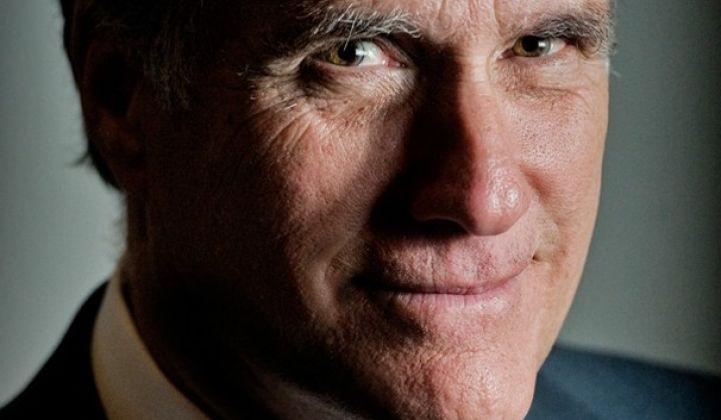The Romney Energy Plan hit my desk last week and I've been thinking about it since. The reality is that the plan is a political document, heavy on grand principles and light on specifics. It sets a goal of achieving energy independence by 2020 through tapping our abundant natural resources, giving states more power over permitting and regulation, and opening public lands and offshore regions to energy development.
The plan is clearly constructed to endear Romney to the oil and gas industry. It notes the now-obvious fact that new drilling techniques have enriched the U.S. with accessible fossil resources. The text is salted with "drill, baby, drill" crowd pleasers such as removing barriers to drilling on public lands, approving the XL pipeline, and opening offshore regions for more exploration. It's hard to feign surprise about this stance from a political perspective. These positions enable Romney to appeal to the right wing of the Republican party and simultaneously open the wallets of a deep-pocketed lobby.
But in an election year that has seen heavy politicization of energy issues, I was anticipating more of an outright attack on renewables. With their need to energize the right (and considering some of both Romney's and Ryan's previous statements), I expected something that looked like the campaign outsourced the energy plan to Halliburton. But it doesn't read that way.
There are a few links to media stories about solar under the "Did You Know?" sections following each policy principle statement. But none of the links are to the typical screeds against solar. And there is no mention of renewables being 'imaginary,' as Romney seemed to believe several weeks ago while on the stump.
Instead, there are a handful of links to media stories about the challenges of permitting solar that support Romney's case that the energy industry is overregulated. A couple of links note that solar and wind power are now competitive in some markets (perhaps to question why solar and wind need support?). And perhaps most surprisingly, there are only two passing mentions of Solyndra in the entire document.
Something I found interesting was how at key turns, where the plan could have focused only on the needs of oil and gas, the plan is careful to be inclusive of wind and solar. It's odd because it undermines Romney's differentiation from Obama, who has staked out an "all of the above" position on energy. Here are a couple of examples from Romney's plan:
- As part of "empowering states" (p. 8), the plan says, "from oil and gas and coal to wind and solar and biofuels, states are far better able to develop, adopt, and enforce regulations based on their unique resources, geology, and local concerns."
- Under the theme of "fair and transparent permitting" (p. 16), the play claims that "overregulation, permitting delays, endless reviews, and senseless litigation interfere with all forms of energy production, from oil and gas drilling to nuclear and coal power generation to the construction of wind farms and solar plants."
- With a nod to "leveling the playing field" (p. 19), the plan advocates "the same policies that will open access to land for oil, gas, and coal development can also open access for the construction of wind, solar, and hydropower facilities."
A similar writing technique is evident in the pains the document goes to use generic terms such as "energy," "natural resources," and "industry" that can be read to refer to both fossil and renewable energy. In that sense, the plan can be interpreted as a kind of cipher that can mean different things to different audiences -- the hallmark of a well-crafted political message.
One might conclude that Romney's advisors are trying to avoid running afoul of the political reality that a large number of voters favor renewable policies. Or perhaps it reflects their experience in a swing state like Iowa, where Romney's strong anti-wind production tax credit stance has become a liability with thousands of Iowans who work in the wind industry. Does reading between the lines reveal an acknowledgment by the campaign that an anti-renewable stance hurts Romney with moderate voters?
The skeptics will say I'm being too generous, that the document is a clear 'wink and nod' to the oil and gas industry and I'm grasping at a few morsels in the plan that seem renewables-friendly.
So let me be clear. It would be a mistake to read the plan naively and conclude Romney supports renewable energy. The plan is a political document that commits a Romney administration to almost nothing concrete and preserves an awful lot of flexibility to construct policy after the election. It hits the hot buttons of the oil and gas industry while avoiding head-on conflict with the majority of Americans who believe in renewables.
Romney's inclusiveness of solar and wind are welcome surprises. However, it's clear the campaign does not believe that climate change is an important issue (it's never mentioned). Nor does it make a case for why (and how easily) our nation could achieve a clean energy future (in addition to an independent energy future). Both of these principles are critically important if you believe in a strong case for renewable energy policy.
Bottom line: No one reading the plan should come away believing that a Romney administration would provide the kind of support for renewables that the Obama administration has. At best, it's interesting to note that while doing the politically necessary things, Romney has left the door open to renewables in his energy policy should he win the trust of the American public.
***
Arno Harris is the CEO of Recurrent Energy.



